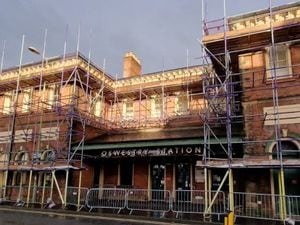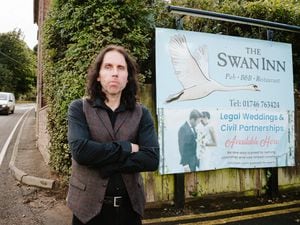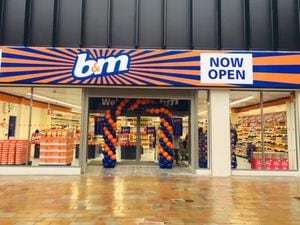The night peace finally broke out: VJ Day 70th anniversary
Many people were in bed when the momentous news filtered through late in the evening of Tuesday, August 14, 1945.
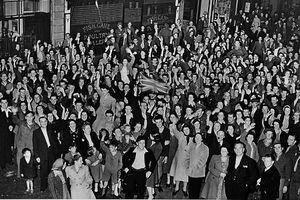
But within a few minutes after midnight, riotous and joyous celebrations began in towns across Shropshire, but particularly in Shrewsbury, the hub of the county where many military personnel were either based or would head for their nights out.
And so it was that the streets in the centre of the county town which had been largely deserted rapidly began to fill up with a noisy throng.
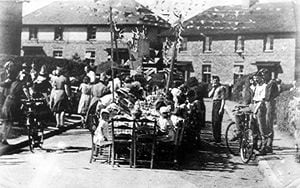
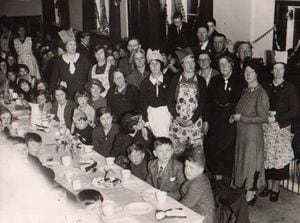
British soldiers, sailors and airmen were fighting thousands of miles from home. The 14th Army, which had fought its way through Burma and scored a major land victory, was dubbed The Forgotten Army.
Elsewhere it was a campaign which involved grim and bloody battles to take islands, stepping stones amid the vast ocean on the way to the Japanese homeland.This required a large British fleet based around a core of aircraft carriers which endured the terror of kamikaze attacks.
Of course, the war was brought to a close following the dropping of the atom bombs on Hiroshima and Nagasaki.
When VJ Day came, many of the prisoners of war were too weak and ill to celebrate.
In the past a number of Salopians have recalled their own experiences, and here from our archives are a selection to give a flavour of what it was like.
Corporal Tom Earp of Shrewsbury was a prisoner of war just outside Nagasaki when the atomic bomb was dropped on the city.
"Everything shook. It was absolutely colossal. Then we saw a great big column of smoke with a massive canopy like a mushroom. The noise was horrendous," he was to recall, speaking in 1995, at the age of 75.
He had no idea what he was witnessing.
"We heard this tremendous explosion, which we thought was caused by American bombers dropping incendiary bombs. We hadn't a clue what it really was."
Driving through the city afterwards, he saw the mass destruction at first hand.
"All the trees and woods had been destroyed, only the buildings were left. It was very, very sad."
Mr Earp had joined the RAF in Shrewsbury at the age of 17, and was working in photographic intelligence in Singapore when the Japanese invaded.
He escaped by ship to Java where he was captured.
"Conditions in the camps were terrible and we were dying like flies. Apart from the lice, fleas and bugs there were the beatings."
"When VJ Day finally came Tom Earp remembers being more relieved than elated.
"We weren't overjoyed because we were in poor health, but we were pleased."
Shrewsbury's Dave Davis, who must have been one of the few people to have survived a firing squad, recalled that there were no great celebrations when he and other prisoners of war discovered the war was over.
"You don't go raving mad, you just kind of soberly begin to accept it. We were literally starving and our main trouble was how to get clothes and food," he said, speaking at the time of the 50th anniversary commemorations.
He was lucky to have survived to see the end of the war, having escaped, been recaptured, and sentenced to death.
"I escaped one day in a fit of pique. I had no chance because the camp was on an island and besides I was a great big Englishman in blue RAF overalls and could easily be detected."
The 21-year-old corporal was soon recaptured and sentenced to death by firing squad. Had he been a private he would have been bayoneted, or if an officer he would have been beheaded.
"I was led out on to the forecourt and stood against the wall. It's strange, but at the time I couldn't really believe it was happening to me – I couldn't believe they were actually going to shoot me."
Moments before the order to fire was given, the camp commandant rushed into the forecourt and, unknown to Corporal Davis, ordered the firing squad not to kill him, but instead to shoot to miss.
"The commandant had got the idea that I'd run away because I wanted to be killed in battle, which was a great honour to the Japanese.
"The guard shot me in the leg and the rest of them shot at the wall and, because I didn't show any fear – partly because I didn't believe it was happening – they didn't kill me because they thought I was very brave. Afterwards I thought they'd just been doing the usual thing of testing your nerve"
Little did he know that the story of this brave young Shropshire POW who had broken out of a Japanese prison camp so that he could be shot and killed in battle was written by a Japanese interpreter, the newspaper clipping being called The Boy Who Wanted To Be Shot.
It was not just those in uniform who suffered. Mrs Miki Harper of Copthorne, Shrewsbury, was only seven when she and her family were rounded up and sent to a Japanese internment camp in Sumatra. Her father was a government official. Miki spent three and a half years in a camp for women and children during which the worst aspect, she recalled, was being separated from her father.
Life in the camp was dominated by the thought of food. Later they were taken to the island of Banka where the squalid conditions and scenes of brutality left an enduring mark on her.
When she found the war was over nobody was fit enough to celebrate. The real rejoicing came when the women and children were reunited with the men.
Some young women were still in their curlers, and some in night attire "without even dressing gowns." Dustbin lids were thrown in the air amid the revelry.
Main focus of the merrymaking was the Square, with about 400 people gathered, including ATS girls from local billets in their pyjamas.
The statue of Lord Clive went through various indignities, including having a beer glass put on his head, which was later replaced by a dustbin lid.
Despite what was described as bedlam, police reported only one untoward incident, with the breaking of a shop window at Wilding's in Castle Street.
"A bonfire blazed merrily in the middle of Castle Street and as the crowd grew, once more the town awoke to life," reported the Wellington Journal and Shrewsbury News.
"ATS personnel and other people, overjoyed, did not trouble to dress and so several pyjama-clad figures were seen in the crowd.
"A policeman was carried shoulder high by the 'Yanks' and eventually deposited on the roof of a lorry. Fire extinguishers caused minor sensations when turned, accidentally or otherwise, on the gathering.
"A saxophone and a trumpet led bands of merrymakers to the Square. Cars were stopped and people clambered on to the roofs. Enforced hooting took place, the crowds refusing to break until car drivers complied with this.
American trucks gave free rides, and lorry loads of waving and cheering demonstrators moved about spreading the good news.
"Lord Clive in the Square was fitted with a makeshift turban, pintpot and watering can and bedecked with flags. Darwin, another "victim" of boisterous mirth, supported several persons on his lap.
"Bonfires were burning in several parts of the town by 1am. In Castlefields, fireworks were set off and a piano on the footpath in Coleham added to the shouting and singing of people gathered round a street bonfire.
"At 2am groups of people paraded in from the suburban areas, and joined in the general exuberance. Although some attempts were made to cause a 'snow storm' with paper scraps, this was not widespread and the streets were comparatively clean in the morning.
"At 3 o'clock the crowds began slowly to disperse, while half-an-hour later only small groups of tired, but happy people, were left to wend their way homewards."
The morning brought pouring rain, but the crowds came out into the town, most of them busy shopping for the two-day holiday. Cigarettes were in short supply and there were queues.
Outside the American Red Cross Club appeared a chalked sign reading: "Well, you good folk, it's all over. Thanks to us all, they did not knock the cliffs off Dover. We will remember you."
The most gaily decorated street was said to be Mardol, thick with flags and bright bunting in the sunshine which followed the morning rain.
During the evening of Wednesday, August 15, the streets filled once more and the Square was "crammed with people jigging and jogging and making a noise, which almost drowned the amplified music."
People climbed on anything that could be climbed, including poor Lord Clive once more, and a conga snaked through the streets to the "music" of two dustbin lids energetically clanged by a soldier.
In Much Wenlock there was a thanksgiving service in Holy Trinity Church on the evening of August 15, conducted by the vicar, the Rev H.E. Winnington-Ingram, and the church and the Guildhall were floodlit. There was dancing in the Memorial Hall and in the square in the town on both Wednesday and Thursday evenings, and the church bells were rung at intervals.
A huge bonfire was lit on Windmill Hill and there was a torchlight procession. Over in St Georges about 500 people assembled on the square, singing, dancing and setting off fireworks until 5am on Wednesday.
A bonfire was lit in the main street in Ironbridge, with people dancing round for hours to music by Mr Eddy Lloyd and his loudspeaker van.
Bridgnorth saw dancing in the street to radio accompaniment and fireworks were let off. There was a bonfire on Pampudding Hill, which had been used during the war as an observation post.
In Ludlow the town council had been criticised for alleged apathy on VE Day, and for VJ Day things were more organised.
HMS Shropshire was a county class heavy cruiser, launched in Glasgow in 1928 by the Countess of Powys, the wife of the Lord Lieutenant of Shropshire, and was commissioned with the Royal Navy the following year.
The first Royal Navy ship to carry the county name, naturally this was a ship Salopians took to their hearts. Among the crew for a time was an obscure Greek prince who had joined the Royal Navy as a cadet in 1939 – Prince Philip.
He served on HMS Shropshire in the East Indies Station and later saw her again when she sailed into Tokyo Bay for the formal signing of the Japanese surrender in September 1945.
She steamed on convoy patrols from Suez to the River Plate, chasing the Graf Spee in the South Atlantic, from Cape Town to the Clyde, and from Durban to Kilindini in Kenya.
In 1942, the people of Shropshire – then numbering 260,900 – raised £2,345,218 to "adopt'' the cruiser during Warships Week.
It was a bitter blow for many residents when Prime Minister Winston Churchill announced in the Commons on September 8, 1942, that the ship would be handed over to the Royal Australian Navy following the sinking of HMAS Canberra.
Now known as HMAS Shropshire, the ship was in action within a short time of her arrival in Australian waters in October 1943, and was prominent in Far Eastern hostilities right to the end.
She was in the Battle of Leyte, in the Philippines, and her guns helped to sink the Japanese battleship Yamashiro. She underwent a severe test in the Battle of Lingayen, in the Philippines, when Australian ships were singled out for Japanese suicide attacks, and took part in the capture of Balik Papan.
HMAS Shropshire was the biggest and most heavily armed ship in the Royal Australian Navy during World War Two and served for a time as its flagship.
She had a displacement of 9,850 tons, and was 633 feet long. In those labour-intensive days she had a large complement of 700, making her like a little town.
Top speed was a smidgeon over 32 knots, and she had eight 8ins guns.
Shropshire kept faith with the Aussie ship.
In the June 1946 victory celebrations Captain Henry Showers and 48 of the ship's company visited Shrewsbury on the invitation of the county council.
Capt Showers was presented with a book of views of Shropshire on behalf of Shropshire Photographic Society, while the crew donated toys to children in the Royal Salop Infirmary.
HMAS Shropshire was paid off in 1949 and returned "home" to be scrapped at Dalmuir, the place where she was launched in Scotland. She was broken up in 1955.
The streets were floodlit and gaily decorated, and the tower of the Butter Cross bore a huge V sign in red, white and blue electric lights, and the stone pillars at the entrance were decorated with laurels. Music played through speakers from the town hall.
Market Drayton greeted the news with people assembling in the streets and singing. The old bells suspended on the Butter Cross were rung for a long time by merrymakers, and about 1am Shropshire Street was ringing with the singing and the sounds of an impromptu band.
From the top of the new flagstaff on the Town Hall the Union Jack, the Stars and Stripes, and the Russian flag, flew throughout the two day holiday, although the display of bunting and flags in the streets was reported to be "not very impressive."
The spontaneous celebrations in Wellington saw a victory bonfire quickly created in the street and a piano and other musical instruments brought into use.
Officially though the town's celebrations started on the Wednesday afternoon in the Square, where the Lilleshall band gave a programme.
"Post-war electric and gas lighting was brought into use, loudspeaker installations were provided and, to wireless music, crowds danced in the Square until the early hours of Thursday," the Wellington Journal and Shrewsbury News said.
"The parish church and other bells rang and there were several services of thanksgiving.
"Street group celebrations were another popular feature and overhead a searchlight displayed the V sign."
Newport had already got to work on planning its VJ Day celebrations some weeks before, and there had been a meeting to discuss the plans only two days before the big day came. They were to follow closely those for VE Day – a service of thanksgiving in the parish church, sports for the children and adults on the grammar school field, tea for children and old people over 65, dancing in the town hall and in the Square, and a bonfire.
This bonfire was lit in the Square on the evening of the Wednesday before a crowd of over 1,000 people, including many from the surrounding villages.
After it had burned for an hour it was put out by the National Fire Service, and dancing on the floodlit Square followed to the music of a military dance band on the balcony of the Vine Vaults. Dominating the scene was the tower of the parish church which was festooned with coloured fairy lights, and the 10ft cross surmounting it was picked out with brilliant lights which could be seen from miles away.
Such illuminations would of course have been very novel, as the blackout had only been relaxed a short time before.

